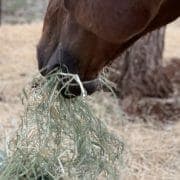Iron: Is There a Link to Laminitis?
Dietary iron is thought by some to contribute to the incidence of laminitis in horses, with serum ferritin starting to be used as the measure of iron status.
It is unclear if this is the case, but in reading human literature, it seems the relationship between serum ferritin and inflammation is a bit of a case of chicken or the egg. Lots of information shows serum ferritin is elevated in humans with inflammatory disease and/or metabolic syndrome, but it is not clear what happened first; did serum ferritin rise and cause inflammation, or did inflammation and cell damage occur and cause elevated serum ferritin?
A good place to start is with a review on serum ferritin. This article tells us that serum ferritin is actually a little protein ball, with a hollow centre where it keeps iron. Depending on how much iron is available in the body, the amount of iron inside the ferritin can vary a lot.
When serum ferritin is measured, it is the protein that is being measured, not the iron. So a serum ferritin measure tells you how many little protein balls are there but not how much iron they actually contain.
The other interesting thing to note is that ferritin is made within cells and is not made in the blood. So it seems that for ferritin to get into the blood it has to come out of the body’s cells (with very limited evidence if any, according to these authors, of any regulated ferritin secretion mechanism in mammals). This leads to the hypothesis that the elevated serum ferritin seen during inflammation is due to leakage from damaged cells into the blood.
The paper goes on to talk about the relationship between serum ferritin and liver iron stores, which are considered the gold standard for assessing body iron stores. While serum ferritin is usually related to liver iron in ‘normal humans’ that don’t have inflammatory disease, serum ferritin can both under and over-estimate liver iron stores where some form of inflammatory disease is at play.
Meaning it is not necessarily a good indicator of overall iron status. These authors suggest serum (‘soluble’) transferrin receptor (sTfR) as being much more useful.
The simple takeaway is that serum ferritin is not necessarily an indicator of iron overload from high dietary iron and may instead be an indicator of inflammation. Maybe the chicken came first… or was it the egg??
Here’s the direct link to the article mentioned above: https://pubs.rsc.org/en/Content/ArticleLanding/%202014/MT/C3MT00347G#!divAbstract
Do you have a question or comment? Do you need help with feeding?
We would love to welcome you to our FeedXL Horse Nutrition Facebook Group. Ask questions and have them answered by PhD and Masters qualified equine nutritionists and spend time with like-minded horse owners. It’s free!
Click here to join the FeedXL Horse Nutrition Facebook Group











